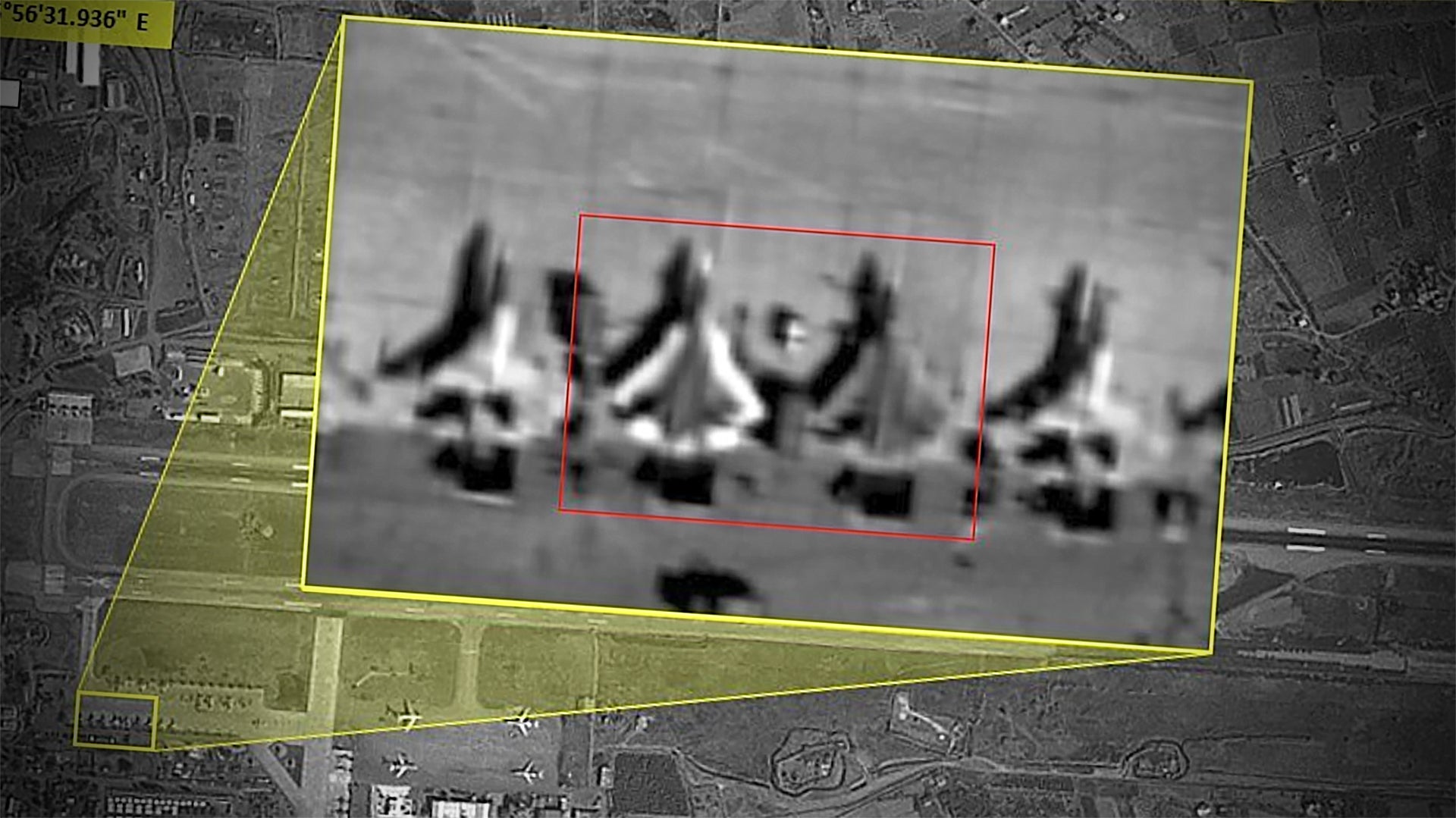Our initial analysis has been outright confirmed and at least two Russian Su-57s have been forward-deployed to Khmeimim Air Base in western Syria. Satellite imagery dated February 23rd, 2018 shows two of the aircraft parked on the base’s tightly packed fixed-wing tactical aircraft ramp.
It appears that one of the aircraft wears the “shark” scheme, first seen of fifth T-50 prototype “Blue 055,” while the other seems to wear a similar paint job, albeit with less contrast and a “pixelated” or “digitized” design first on T-50 “Blue 509.”
Blue 055 suffered a bad engine fire during a ground run in 2014, resulting in severe damage to its airframe. The aircraft was returned to flying condition in 2016 by using parts from an unfinished T-50 prototype.
Another satellite image appears to show an Su-57 cocooned in modular barriers on the base’s southern ramp area, possibly taken at a later time than the image above. We must note that the origin of this image has not been confirmed.
The barriers, which can be used to create temporary revetments, have began to appear at the base following a series of attacks, one of which was executed via a group of GPS guided drones, in early January.
Some sources have claimed two additional Su-57s arrived the day after the initial pair, with images showing a pair of the jets flanked by Su-35s approaching the base. From what we can tell, this is just another angle of the first pair arriving, but with limited information available, we cannot rule out the presence of four Su-57s instead of just the pair.
Russia usually sends batches of four high-end tactical jets to the Syrian theater at a time, and just two would make generating sorties very challenging, especially considering the aircraft is still quite immature. But there are roughly a dozen Su-57s (also known by its pre-operational T-50 designation) in existence, and many of them are early prototype models. So the idea that Russia would commit four to Syria at such an early time would be a bold move, but not really an unexpected one.
We have discussed the reasons why Russia would execute such a surprise deployment of their most technologically advanced combat aircraft, but beyond the marketing and tactical aspects of the operation, Moscow’s choice to send the Su-57 to Syria shouldn’t be surprising, as we have said it would be just a matter of time.
The country has a more flexible rubric for deploying an asset into an operational combat theater than the U.S., which could be seen by some as one luxury of having little opposition oversight, especially by the media, of major defense projects. It also is indicative of how Russia develops its weaponry, which allows for greater operational risk early on in the system’s lifecycle.

Regardless, the jets will likely undergo what the Kremlin calls “combat evaluation,” which will work to test the aircraft’s systems over an actual combat zone and to make the case for the jet to potential export customers. It is also likely aimed at saving the long-struggling deal between New Delhi and Moscow to produce an India-specific version of the jet.
Russia’s initiative to showcase its weapon systems in Syria, and slapping on the “proven in combat” badge of approval on them, has indeed worked well over the past two and a half years when it comes to drumming up sales of some of the country’s most technologically advanced and expensive weapons to foreign customers.
Russia itself has struggled to buy significant numbers of Su-57s even as the program winds down primary development and moves towards operational testing. Instead the Ministry of Defense has ended up purchasing less expensive and far more mature Su-35s instead. The War Zone wrote the following in 2017:
“Despite initial plans to have built 150 of Sukhoi’s T-50 stealth fighter by 2020, the Kremlin has now scaled that back to a buy of just a dozen aircraft. This year, after more than seven years of flight testing, the Russian military hopes to finally take delivery of the 10th and 11th pre-production prototypes.”
Now we’ll have to wait and see how Russia publicizes the Su-57’s presence in Syria and if they attempt to challenge airspace patrolled by American fighters, namely F-22 Raptors. And yes, this plot setup sounds exactly like it was ripped right out of a somewhat far-fetched military techno-thriller novel.
Strange times indeed.
Contact the author: Tyler@thedrive.com
